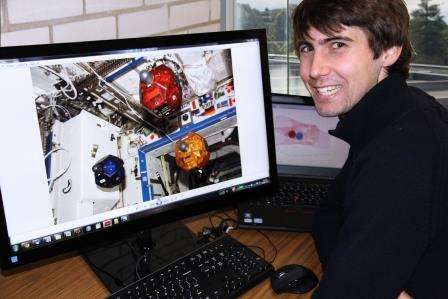Flight of fiction, now future prediction

Personal air vehicles (PAVs), lightweight four to five-seater aircraft that anyone with a driver's licence could fly are in the not too distant future according to a University of Sydney aeronautical student.
The prediction from Dana King comes ahead of the 75th anniversary celebration of aeronautical engineering on 4 July.
The 20-year-old student from Perth, studying a combined Bachelor of Engineering (Aeronautical) and Bachelor of Project Management (Civil Engineering Science), sees a future in the design and development of rotorcraftor rotary-wing aircraft where she can utilise her expertise in aerodynamics.
"When people think aerodynamics, they think only about the commercial airline industry. It's so much more than that. With my degree I can work on projects involving not just aircraft but also, unmanned aerial vehicles (UAV's), helicopters.
"Aerodynamics is a secret weapon in almost every engineering field, "says Dana.
Dana sees the industry surging towards being more commercially available and playing a more prominent role in our transport system.
"From commercial space flights to PAV's, the push is there and the global desire for fast, cheap travel is a strong driver for our industry,"says Dana.
Professor Andy Dong, Warren Centre Chair for Engineering Innovation at the University agrees with Dana's predictions for the future of aviation.
"Our built environment will start to change to accommodate aerial transport of people and goods - your garage will not be on the ground floor, especially as Australians progress towards vertical living in high -rise apartment blocks," Professor Dong says.
The innovation professor also envisages that we'll have personal aerial assistants - aerial vehicle that can do things like walk our dogs, keep an eye out on the kids playing at the park, help disabled people to get around and deliver goods.
Aeronautical engineering Ph.D. candidate Ben Morrell, who is conducting research in control systems for autonomous robots aboard the International Space Station (ISS). This straight-A student predicts that UAVs will become more and more widespread, used in fields such as search and rescue, agriculture, environmental monitoring, cinematography and cargo delivery.
Ben's goal is to be part of a team that is pushing the boundaries of space exploration. His research is investigating the role of robotic spacecraft, 'spheres', and their ability to move autonomously around the ISS. The work has the potential to be applied to the maintenance of the ISS, deep space exploration and space mining. Ben says his research was inspired by the flying orbs in Star Wars.
"Space is the new frontier,"says Ben, who sees the galaxy opening up more and more to commercial entities such as Space X, Orbital Sciences and Virgin Galactic.
"Within maybe a decade we will see more missions to Mars and more human presence in space," says Ben.
"Space mining will eventually become a reality. This would be driven largely by autonomous systems such as the robotic spacecraft I am investigating," he says.
Ben also predicts there will be new and innovative uses for satellites, and greater satellite coverage of earth.
David Cox, aeronautical engineer and chief operation officer of the Faculty of Engineering and Information Technologies agrees with Dana and Ben and says the aviation industry has a promising future.
Here are their top ten predictions for the aviation industry
- Australia will operate commercial aircraft that use 25 per cent less fuel.
- Aviation biofuels will become a major industry for Australia.
- Autonomous aircraft will become a reality with the first un-piloted mission a military cargo operation.
- An Unmanned Flying Doctor Service will be used to efficiently transport medical supplies to outback Australia.
- Airport of the future - a completely automated airport from baggage handling to aircraft tugging, to talking directly to aircraft system and not the pilot.
- Environmental robotic aircraft - will keep an eye on the environment with long endurance flights that can intelligently use wind energy like eagles and albatrosses. They would be used to supply farmers and environment agencies with valuable information on animal movement (land, air and sea), pests and land usage.
- Mining the galaxy - space mining will start to become a reality, largely driven by unmanned autonomous systems. It will start to set the platform for a greater human presence in space.
- Humans in space - space will open up with more commercial entities such as Space X launching spacecraft, and progressing towards reusable rockets and regular manned spaceflights.
- Connecting the globe - there will be new and innovative uses for satellites, and greater satellite coverage of earth due to cheaper satellites and cheaper launches: meaning more and more people can be involved with space technology.
- Flying cars and private air vehicles will be available to the general public opening up highways in the sky. These four to five-seater craft would allow anyone with a driver's licence to fly.
Provided by University of Sydney


















